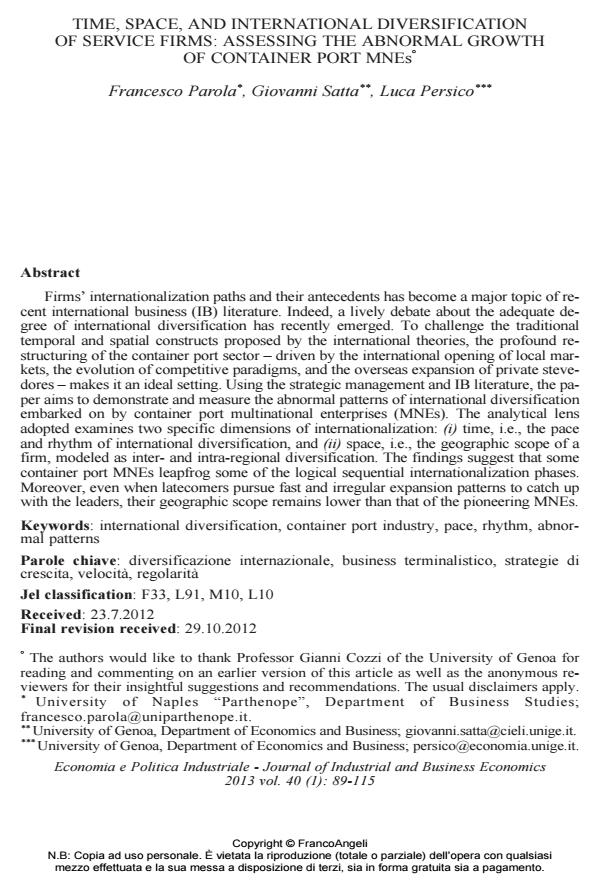Time, space, and international diversification of service firms: assessing the abnormal growth of container port MNs
Titolo Rivista ECONOMIA E POLITICA INDUSTRIALE
Autori/Curatori Francesco Parola, Giovanni Satta, Luca Persico
Anno di pubblicazione 2013 Fascicolo 2013/1
Lingua Italiano Numero pagine 27 P. 90-115 Dimensione file 377 KB
DOI 10.3280/POLI2013-001004
Il DOI è il codice a barre della proprietà intellettuale: per saperne di più
clicca qui
Qui sotto puoi vedere in anteprima la prima pagina di questo articolo.
Se questo articolo ti interessa, lo puoi acquistare (e scaricare in formato pdf) seguendo le facili indicazioni per acquistare il download credit. Acquista Download Credits per scaricare questo Articolo in formato PDF

FrancoAngeli è membro della Publishers International Linking Association, Inc (PILA)associazione indipendente e non profit per facilitare (attraverso i servizi tecnologici implementati da CrossRef.org) l’accesso degli studiosi ai contenuti digitali nelle pubblicazioni professionali e scientifiche
Firms’ internationalization paths and their antecedents has become a major topic of recent international business (IB) literature. Indeed, a lively debate about the adequate degree of international diversification has recently emerged. To challenge the traditional temporal and spatial constructs proposed by the international theories, the profound restructuring of the container port sector - driven by the international opening of local markets, the evolution of competitive paradigms, and the overseas expansion of private stevedores - makes it an ideal setting. Using the strategic management and IB literature, the paper aims to demonstrate and measure the abnormal patterns of international diversification embarked on by container port multinational enterprises (MNEs). The analytical lens adopted examines two specific dimensions of internationalization: (i) time, i.e., the pace and rhythm of international diversification, and (ii) space, i.e., the geographic scope of a firm, modeled as inter- and intra-regional diversification. The findings suggest that some container port MNEs leapfrog some of the logical sequential internationalization phases. Moreover, even when latecomers pursue fast and irregular expansion patterns to catch up with the leaders, their geographic scope remains lower than that of the pioneering MNEs.
Parole chiave:Diversificazione internazionale, business terminalistico, strategie di crescita, velocità, regolarità
Jel codes:F33, L91, M10, L10
- Corporate strategies and profitability of maritime logistics firms Francesco Parola, Giovanni Satta, Photis M Panayides, in Maritime Economics & Logistics /2015 pp.52
DOI: 10.1057/mel.2014.18 - L'impatto delle strategie corporate sulle performance delle imprese di logistica via mare Francesco Parola, Giovanni Satta, Riccardo Spinelli, in ECONOMIA E DIRITTO DEL TERZIARIO 2/2014 pp.201
DOI: 10.3280/ED2013-002002 - Entry mode choices of rapidly internationalizing terminal operators: Giovanni Satta, Luca Persico, in Maritime Economics & Logistics /2015 pp.97
DOI: 10.1057/mel.2014.32
Francesco Parola, Giovanni Satta, Luca Persico, Time, space, and international diversification of service firms: assessing the abnormal growth of container port MNs in "ECONOMIA E POLITICA INDUSTRIALE " 1/2013, pp 90-115, DOI: 10.3280/POLI2013-001004